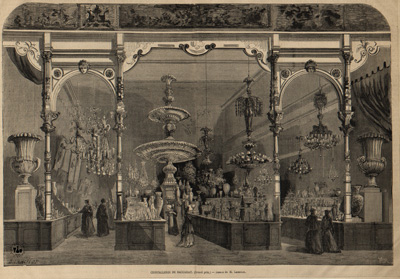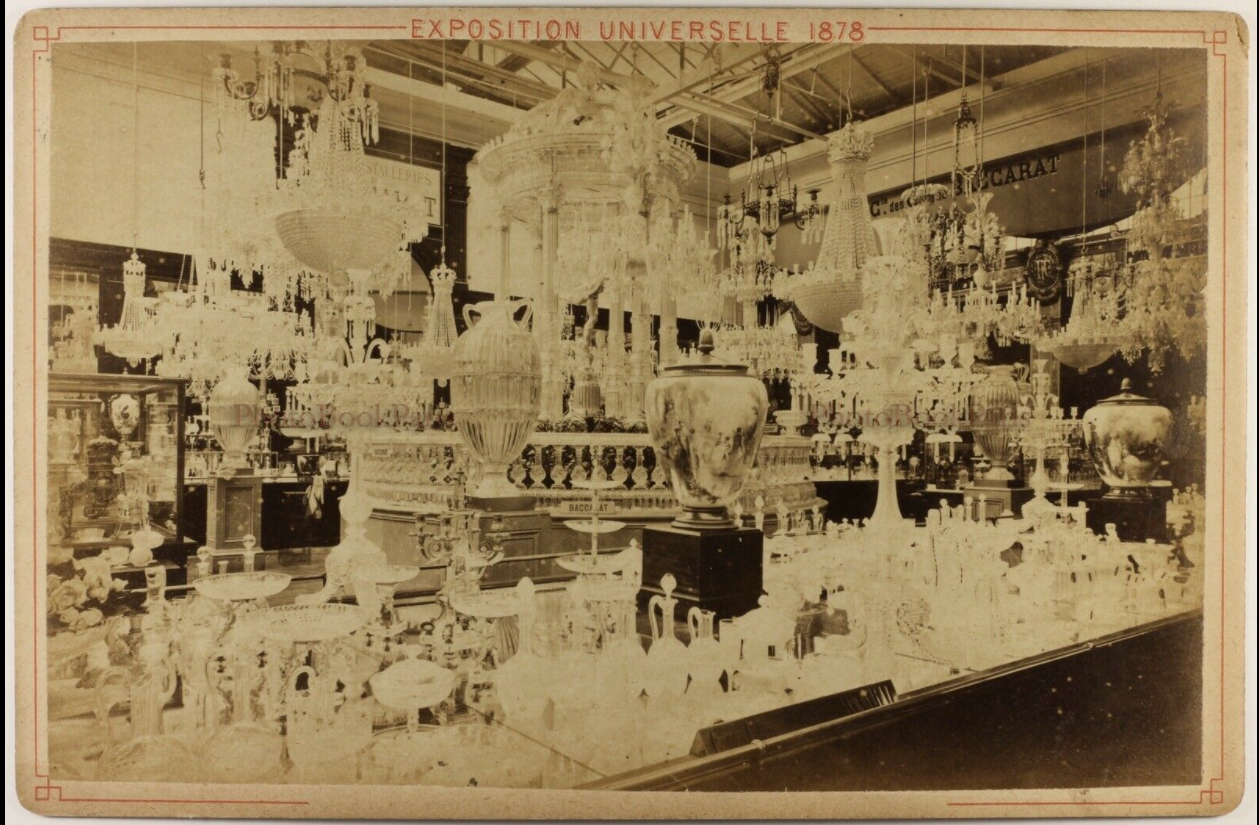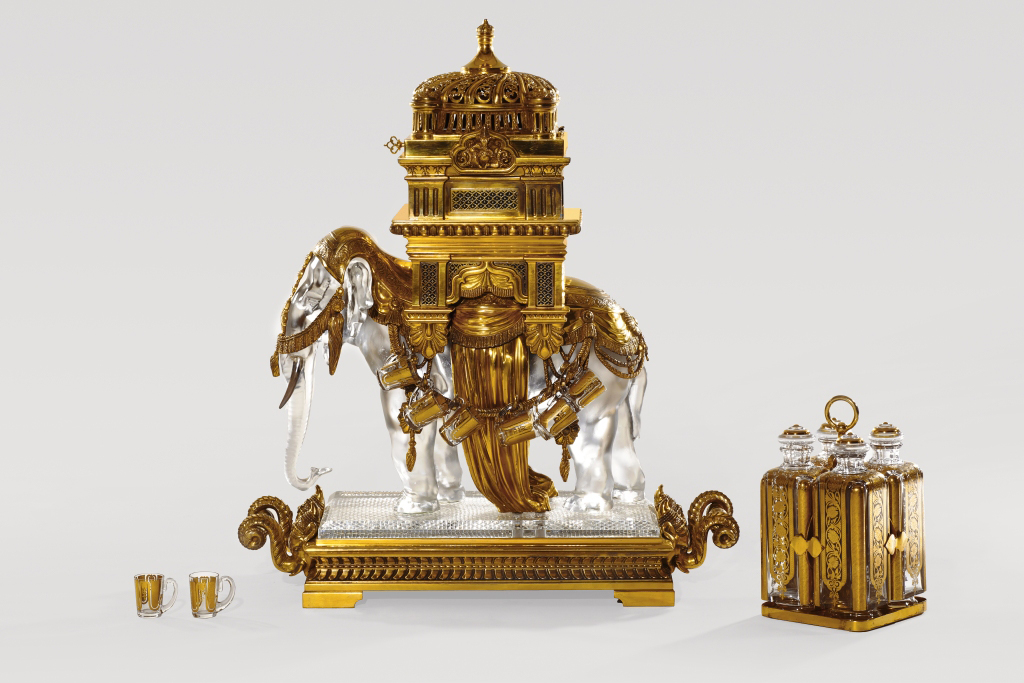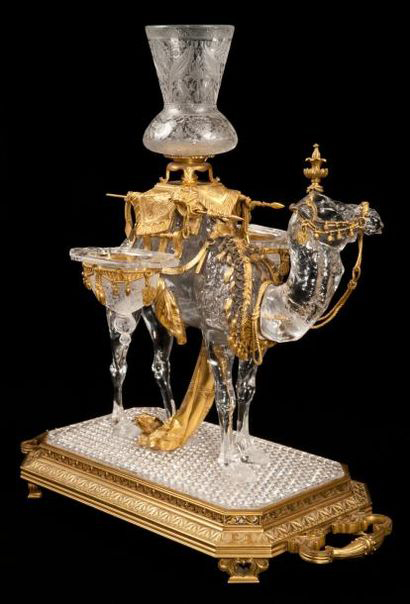BACCARAT in the 19th century
Download PDFCreated under the reign of Louis XV, the crystal manufactory owes its international reputation to its participation all along the 19th century and until 1937 to the important exhibitions. It’s during this period that the factory illustrates itself to the eyes of the world by the excellency of its production and its continue innovation research, winning each time medals. Its creation influences the other European glass and crystal factories during the following decades and giving the way for the techniques and stylistic models.
The technical innovations
Indeed, from 1824, the crystal cutter's workshop is furnished with a hundred of wheels working thanks to the hydraulic energy and not anymore with the only feet strength of the cutters. Thus, Baccarat is the first French crystal factory to adopt this system from England. On the same year, a glass maker from the crystal factory, Ismaël Robinet, has the idea to link one of the stick’s end to an air compressor pump. This process is then taken by many crystal factories and makes its inventor win a gold medal and a pension for life by Baccarat. Nevertheless, this innovation is replaced in the early 1830’s by a new technique from the United States. From 1839, the wheel engraving doesn’t stop to develop because of an important commercial success of its decorations, obliging Baccarat to search for ways to produce more and for less money. Thus, the crystal factory buys in 1865, the process of engraving with a Hydrofluoric acid bath, invented by the chemist L. Kessler, and immediately uses it in its production, allowing them to produce less expensive elaborated decors. It’s also at Baccarat that one of the main problem met during the creation of the crystal is solved: the obtaining of a material perfectly transparent, without any trace of coloration. This solution is found by the engineer François-Eugène de Fontenay, who decides in 1840 to replace the Manganese oxide by the Nickel oxide. True leap in the crystal industry, this new method permits the crystal factory to win a gold medal during the Exposition des produits de l’industrie française in 1844. Finally, it’s also at Baccarat that the most beautiful colored crystal are invented, of which the multiple shades make them win another Gold medal during the Exposition des produits de l’Industrie française in 1839 and eclipse the competition from Bohemia, which had the techniques most elaborated until this date. Among the most famous colors we can name the Agatha Green and the Celeste Blue created in 1842, or even the pink and the Ruby Red, invented in 1847 and the numerous green shades like the Emerald green of the Parrot green.
The World Fairs
Baccarat, as many other French industry, refuses to participate to the first World Fair taking place in London in 1851, by fear of a potential competition and by opposition to any ideas of free exchange. One has to wait four years later, when the second event is organized in Paris, for the factory to exhibit two huge candelabrum, being more than 5m high and each holding a bouquet of 90 candles, and an exceptional chandelier by its size (5m x 3m) lightened up with 140 candles playing with the thousands of pendants. Baccarat wins there the Grande médaille d’honneur and is then put at the head of the European crystal maker factories.
During its second participation at the 1867 event in Paris, Baccarat displays a monumental fountain of more than 7m high, two vases engraved by Jean-Baptiste Simon, and many sets, cups, vases and chandeliers. Baccarat wins the highest reward, the Grand Prix and its administrator Emile Godard-Desmaret, is made Officier de la Légion d’Honneur.
During the 1878 World Fair in Paris, the master piece of the crystal factory is a rotunda temple containing a flying Hermes in silvered bronze from a sculpture by Giambologna bought by the King of Portugal Don Louis in 1892. They also exhibit a series of chandeliers copied from 16th century originals conserved in the Louvre museum, for which the critic will reproach a lack of creativity. Yet, some Middle East and Japan inspired pieces were already exhibited, announcing a stylistic evolution. Even though the opinion were divergent, Baccarat again wins the Grand Prix.
Baccarat does not directly participate to the 1900 World Fair but is presented in the Social economic section and wins two Grands Prix for the work salary and the foresight institutions. Nevertheless, the Parisian store « Le Grand Dépôt »¹ also called « Palais des Arts et du Feu » presents during the fair two sumptuous crystal pieces. They are two huge boats adorned with bronze, sculpted by Charles Vital-Cornu, symbolizing the city of Paris. One of them is today in the Corning Museum of Glass, the other among the pearls of an Indian palace in Bikaner.
The commercial adaptation
The second half of the 19th century is marked by many politic disruptions that are generating an economical life particularly unsteady to which Baccarat has to adapt. In the late 1850’s, the structuring of Paris encourages the bourgeoisie to build buildings and private mansions which provoke an increase of the chandeliers and table sets orders in the factory. During the Second Empire, Baccarat benefits from the World Fairs and importantly increases the export sales, then they arrange a careful politic for the production and stock management between 1874 and 1914 allowing the crystal making factory to resist all along the disturbance of the last quarter of the 19th century. In 1908, rooms adjoining the store are equipped to cope with the modernization of the chandeliers linked with the development of the electricity, according to the wish expressed during the administration council: « We don’t have the possibility to show to the buyers the electric chandeliers in conditions that allow them to judge the different effects in the space they’ll be set. This gap harms the sale and we wanted to fill it by installing rooms of similar dimensions of the ones we can find on the bourgeois apartments. »
The signature
The crystal maker factory’s production is very rarely signed between 1764 and 1860, year during which appear the first stuck paper labels depicting a carafe, a wine glass and a tumbler. Unfortunately, few are still present on the pieces produced during this period as once the object was bought, the label was usually taken off. In 1875, the stamp with the factory’s name appears on some molded models and the bronze parts. From the 1920’s the perfume bottles are always signed but we truly have to wait for 1936 for the “BACCARAT” mark accompanied with a carafe and two glasses to appear on the whole production except the chandeliers. Indeed, it’s only from 1997, that all the chandeliers are distinguished by a pearl made of red crystal.
¹This store was opened in 1863, on the rue Drouot on Émile Bourgeois’ initiative, there he mainly proposes for commerce silver, ceramic, porcelain, glass and crystal articles coming from the most renown French and foreign factories.
Bibliography
Baccarat: la légende du cristal; [catalogue d'Exposition "Baccarat, la légende du cristal", présentée au Petit Palais, Musée des Beaux-Arts de la Ville de Paris du 15 octobre 2014 au 4 janvier 2015]
Sautot Dany, Baccarat, une manufacture française, editions Massins, Paris, 2003

Musée d'Orsay, Paris


Musée d'Orsay, Paris
© Musée d’Orsay, Dist. RMN-Grand Palais / Patrice Schmidt

Corning Museum of Glass


Corning Museum of Glass

1867 World Fair


© Roger-Viollet



Collection patrimoniale Baccarat

Collection Jay et Jeanie Schottenstein















